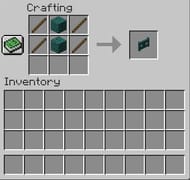- Create Wiki Page
- All Pages

Fence Gates are similar to Doors, except that they are 1.5 blocks tall, attached to transparent blocks, and have no connection to Zombies or Villagers. Since doors cannot connect with fences due to their transparency, they are often used as pens' gates. When placing fence gates, make sure the wide side is facing the match. They will also open in the opposite direction from which they were opened.
Fence gates provide easy access to fenced-in areas without the need to climb over blocks or ladders. They are only opened by right-clicking the gate and always open away from the player.
1. 4 Sticks
2. 2 Planks
A stick in Minecraft is an important simple object that is used to build several other items in the game. They are used purely for crafting material since they cannot be placed in the world or utilized on their own. 4 sticks at a time will be produced by the following crafting process:
Planks can be used to construct a support style for buildings as well as homes, huts, and shacks. Planks of wood are a sustainable resource. Even though it is easily burned, wood is abundant in biomes with trees, making it a valuable building material.
Naturally generated wood planks can be found in abandoned mine shafts, villages, pillager outposts, shipwrecks, woodland mansions, and witch huts. Oak-wood planks are used in villages and mineshafts, dark oak wood planks are used in abandoned mineshafts and badlands biomes, and spruce planks are seen in swamp huts. These are all of the types of wood that exist in Minecraft:
As there are 8 different types of planks, you can make 8 different kinds of fence gates. Soon another type of wood, called Mangrove, will be introduced into the game making it 9 potential fence gates. The different types of wood only offer decorative value and all of these fence gates behave identically.
In a Nutshell:
To make Fence Gates, open the crafting table containing the 3x3 grid. Then place sticks on either side of the first and second row, and then place two planks in the center of both rows so that the same pattern is made in both rows. Now that fence gates have been made, simply click it and drag it to your inventory.
Open your crafting table to begin crafting planks with the obtained ingredients contained in your inventory. Once you open your crafting table you will have the 3x3 crafting grid similar to the picture below:

Place the sticks on either side of the first and second row leaving the middleboxes in each of the rows.

In the center of both, the first and second row, place a wooden plank. In this case, an oak plank is shown in the picture below.

Finally, move the fence gate from the top-right most square and into your inventory. You can place the fence gate with a right click or left trigger.


While the other processes are the same, the main difference is the type of log to obtain. Regular birch trees generate in forests, birch forests, and dark forests, while tall birch trees only generate in tall birch forests.
A jungle tree is a generated structure native to the jungle biome. Jungle trees range from short bushes to tall trees that reach up to 30 blocks in height.


Spruce trees are mainly found in the taiga biome, but they may also generate in wooded mountains, snowy tundra, snowy taiga, and giant tree taiga biomes. Their logs have the same texture as oak logs, but it is a darker shade of brown; its leaves are denser, with a darker and blueish tone.

A dark oak tree is a variant of the Oaktree with a thick trunk. They are found in the dark forest biome.

The acacia tree is found in the savanna biome. Acacia trees are around 8 blocks tall and feature unique diagonal trunks, and may occasionally have multiple canopies.

The crimson forest is dense and has a crimson color scheme. The forest's fog is dark red and blazing particles are seen floating.

The Warped Forest is the most peaceful and safest biome found in the Nether since no hostile mobs spawn here naturally. The forest is dense and has a cyan color scheme.
Like regular fences, fence gates appear to only be one block tall. However, the height of the block prevents most mobs from being able to hop over it. Some mobs like spiders, foxes, and other high jumpers can easily climb over one fence block.
Having two fence blocks on top of each other does not stack its unique height. In other words, two fence gates/blocks on top of each other will count the block at the bottom and the height of the block on top of it.
While fence blocks will connect to each other around corners, fence gates require adjacent fence posts in order to enclose the area. You cannot place a fence gate as the corner post without leaving an opening in the fence.
Congratulations! You have made fence gates of every wood type possible. You can use the fence gates as a switchable barrier that can be opened and closed by hand or by Redstone power. To place a fence gate, use the Place Block control while pointing at a block facing the space the fence gate should occupy. When placed, a fence gate automatically faces toward the player who placed it, regardless of any other fences around it. Hostile mobs recognize closed fence gates as a block and cannot detect players through it unless they were already detected.